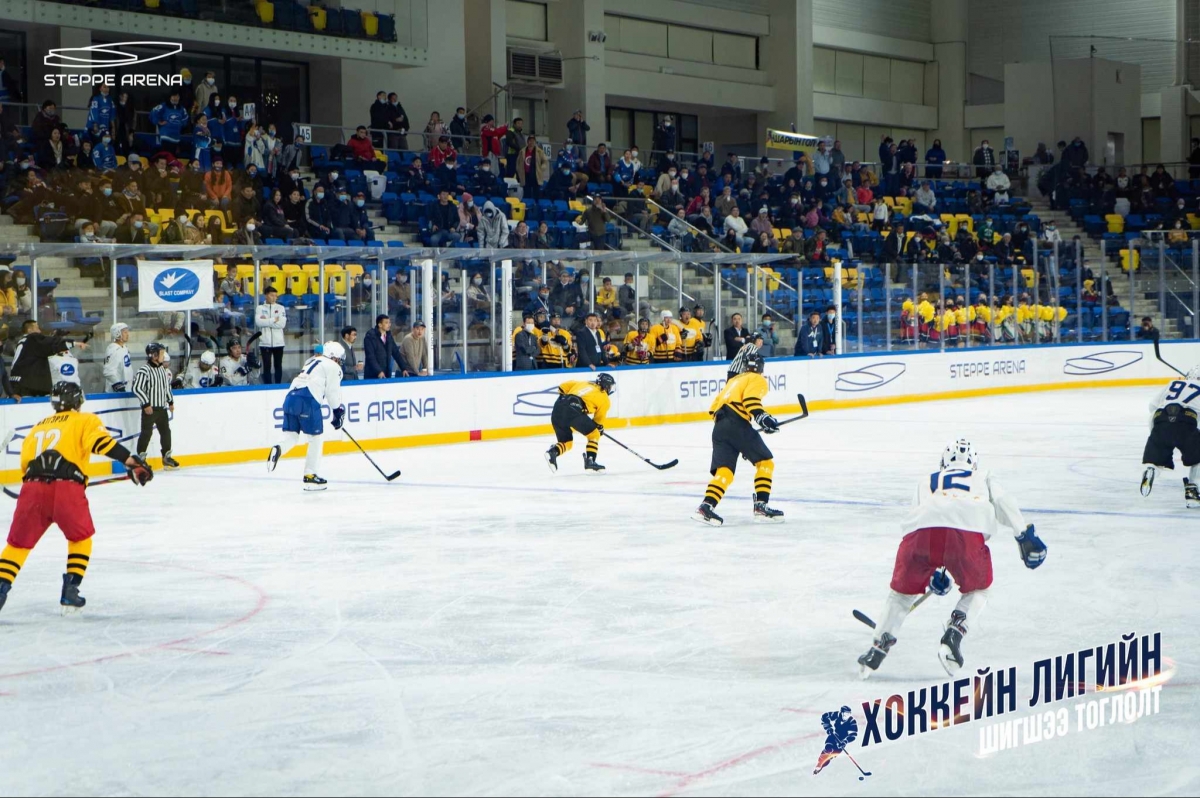
An interview with the General Manager of AIC Steppe Arena Enkhbayar Tsedendorj
“Why Did the AIC Steppe Arena Melt Its Ice?”
After three years of operation, the Olympic-standard AIC Steppe Arena invited visitors to “enjoy the few remaining days on ice” through its social media pages. This piqued my curiosity as a journalist, prompting me to visit the venue for more details.
From the outside, the unique and interesting design of the AIC Steppe Arena sparked my curiosity, prompting me to learn more about the facility as I entered. When I politely expressed my desire to get information about the facility to the welcoming staff, they responded with “Just a moment” and invited me inside. I arrived just as they were finishing the ice-melting process. After inquiring about the person who could provide information, I shared my purpose and was warmly welcomed for a discussion. Thus, I had the opportunity to interview Enkhbayar Tsedendorj, the General Manager of Steppe Arena LLC.

AIC Steppe Arena appears to require a significant investment and is a large structure with a unique design. What was the reason for its construction? What is its capacity?
Our country ranks third on the list of the ten coldest countries in the world, following Canada and Russia. Mongolians have a history of developing winter sports and games during the cold season. I would guess it is rare to find people from our generation who haven’t skated on river ice with skates attached to their felt boots secured with firewood. I remember, that later, with the introduction of boot skates and the influence of Russians living here in Mongolia, several outdoor ice rinks were established in Ulaanbaatar, Darkhan, and Erdenet, where people engaged in hockey and skating competitions.
While these memories are cherished, they also mark the beginning of a dream to build a facility for winter sports within our country, allowing people to spend their leisure time there and watch tournaments. The older generation reminisces about skating in their youth, while children and young people are now increasingly interested in engaging in various ice sports to develop their physical fitness. I believe this reflects the dreams of all those who contributed to the creation of this arena.
In terms of capacity, this arena meets the Olympic standard, with a capacity to seat 2,670 and a floor area of 1,800 m². It is fully equipped with modern technology and equipment, featuring Mongolia’s first ventilation system. The facility is intended for social services and can host a variety of events and activities.
You mentioned countries with cold winters. What other countries are included? How many such facilities exist in those countries?
After Mongolia, countries like Norway, Kyrgyzstan, Finland, Iceland, Tajikistan, Sweden, and Estonia are included. It looks like the development of winter sports and the physical fitness of the public is closely linked to government policy. That’s why international major events like the Winter Olympics are of great significance. We know that athletes from countries with numerous sports facilities tend to achieve higher success in these Olympics. Winter sports facilities are classified into two categories: indoor arenas and outdoor rinks. As of 2023, for example, Canada has 2,860 indoor arenas and over 5,000 outdoor ice rinks, while the U.S. has 2,101 and 500, Russia has 807 and 5,990, and Sweden has 374 and 75, respectively. And our neighboring China reportedly has 104 indoor arenas.
It’s impressive that there are so many facilities. How do they manage to do so?
This can be understood as the implementation of state policies aimed at promoting a healthy lifestyle and physical development for their citizens, as well as supporting and developing professional sports. Therefore, in establishing these kinds of arenas, national and local authorities collaborate with the private sector by providing land, ensuring infrastructure, and investments, financing operational costs post-construction, offering incentives, supporting through tax policies, and organizing competitions.
One significant factor for ice arenas is the quality of the ice. For instance, when hosting performances by top Russian figure skating masters, one of the conditions was the standard of our arena, particularly the quality of the ice. Generally, maintaining ice requires high operational costs to keep the technology, usage, and services at a standard level. Thus, with support from state and local governments for the public good, most arenas can operate smoothly.
So, how does a facility like AIC Steppe Arena operate and maintain regular activities through public-private partnerships focused on developing public physical fitness?
We have joined an international association of such facilities, studied their experiences, and implemented them in our operations. As mentioned above, within the framework of state policy, the development of public physical and mental well-being is supported through public-private partnerships. This includes financing operational costs, providing grants, and offering tax incentives to ensure that construction and operations are sustainable and purpose-driven. Such collaboration allows us to maintain consistent and effective activities in our facility.
For instance, the well-known sports complex in Calgary, Canada, was established through public-private investment, with the Calgary city government financing a portion of the facility’s operational costs and exempting it from property taxes. Many similar examples can be cited.
In general, the establishment of such sports venues not only broadens the scope of sports events for the population but also creates opportunities to host major international tournaments and events. Research indicates that overseas visitors and athletes participating in international events spend at least one thousand dollars on services such as hotels, shops, restaurants, and transportation. This not only enhances the country’s reputation but also improves the rankings of athletes and contributes positively to the economy.
What events have you held in the past three years related to ice sports?
Over the past three years, we have hosted various tournaments in hockey, short track, and figure skating, including world and national championships. We have organized the national championships and friendly matches for both youth and adult ice hockey. In 2022, we hosted a performance by world and Olympic figure skating masters, and we collaborated on training sessions with figure skating masters from the USA and Japan in 2022 and 2023. Additionally, we have our instructors and have conducted beginner and intermediate skating courses, involving over 200 juniors. The national short track team has also been training and participating in world and continental competitions. In total, we have served over a million people during this period.
Can you briefly talk about the story of AIC Steppe Arena?
The idea of creating an Olympic-standard indoor winter sports venue in Mongolia was initiated and realized by Tsagaan Puntsag. He is a representative of the older generation who spent his childhood skating on the ice of rivers with felt boots. He aimed to contribute to future generations by creating a facility he dreamed of. Tsagaan and I were classmates at 21st secondary school in Ulaanbaatar. I know well that he always read and dreamt of many things and had many aspirations. This facility was built for the future of Mongolian youth and to fulfill his dreams. I have worked in housing, urban planning, and development, and infrastructure, in both public and private sectors, as well as with international organizations. I was invited by my classmate to help ensure the efficient and sustainable operation of this venue, and I am working with these young people today.
I heard of the ice-melting process at the AIC Steppe Arena. That was the main reason for meeting you.
Building such a facility is a significant undertaking. Equally important is ensuring the quality of construction from the beginning and maintaining operations to prolong its lifespan. This involves independent asset management providing quality and regular maintenance for the building’s materials and equipment according to technical standards.
In our facility, we have implemented many new structural solutions, such as using large-span architectural designs. Additionally, ice is a vital component of our facility. Therefore, maintaining the ice at a consistent standard level and organizing its use, maintenance, and monitoring according to technical requirements incurs very high costs. We have installed the latest ice-freezing equipment from Austria and Finland. Before constructing this facility, we studied the best global examples to adapt the best practices for Mongolia.
On the other hand, the operational costs for maintaining the building and equipment are very high. Since the private sector alone cannot bear these costs, we reluctantly decided to melt the ice to reduce expenses and apologize to our ice sports enthusiasts. The electricity cost for the ice-making equipment alone is about MNT11 million per week. There are times when I think there should be more policies to support public sports facilities.
Recently, my seven-year-old granddaughter, who came to skate, asked, “When can we come back?” When I told her, “There won’t be ice for a while,” she frowned and asked, “Why?” (laughs). We have many regular customers, including children and youth learning to skate, as well as hockey teams that practice and compete. They all have to wait for the ice, so I apologize to everyone. I hope we meet again and skate together!
What do you think is needed for efficient operation in the future?
This facility, which meets international Olympic standards, has an area of 1,800 m2, seats 2,670 people, and is equipped with modern techniques and equipment. It is located in Ulaanbaatar, Mongolia, not abroad. Many citizens are proud of this facility and want to use it. On the other hand, this facility can host all kinds of events involving other sports, arts, culture and community. For us, it is not yet possible to fully cover the costs.
Therefore, I would like to emphasize the importance of real support and cooperation between the government and the city of Ulaanbaatar as a social service center. It would be good if they provided support such as co-organization of major international and national competitions, current expenses, and tax benefits.
Internationally, there is a practice of naming the palace after the authorized organization for a certain period to support the activities of large arenas within the scope of social responsibility. Accordingly, we sold the naming rights a year ago and received offers from several companies, including Achit-Ikht. However, due to the impact of the tax audit, that support stopped coming in, which is one of the reasons for our ice to melt. It is right for the government to monitor and inspect the activities of companies, but if there is no opportunity to support the private sector to run normally, it should not be hindered by inspections. I want the government to support the private sector through its policies to enable it to work well, collect taxes, and spend them efficiently, effectively, and appropriately for the welfare of society. Therefore, as the person in charge of this venue, it would be better if the state and the local government supported it through policy. We believe and wait for that time to come.
/An offficial translation from Мөсөн өргөө мөсөө яагаад хайлуулав : Тал нутгийн цахим мэдээлэлийн сайт (mminfo.mn) by Bodibilguun Galsan/
© 2026 STEPPE COPPER - All rights reserved.
The information provided by Steppe Copper LLC on https://steppecopper.mn/ is for general informational purposes only.